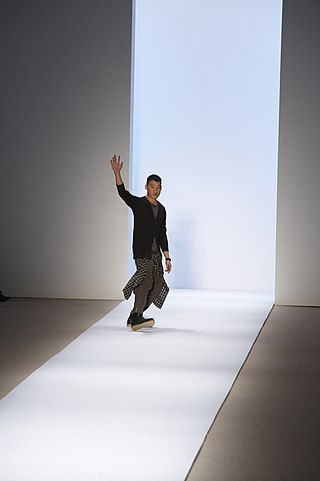 | |
| Type | Private [1] |
|---|---|
| Industry | Fashion |
| Founded | Suffolk, United Kingdom (1989) |
| Headquarters | , United Kingdom |
| Products | Men's Clothing Accessories |
| Website | duchamplondon |
Duchamp is a British men's luxury clothing and accessories company founded in 1989.
 | |
| Type | Private [1] |
|---|---|
| Industry | Fashion |
| Founded | Suffolk, United Kingdom (1989) |
| Headquarters | , United Kingdom |
| Products | Men's Clothing Accessories |
| Website | duchamplondon |
Duchamp is a British men's luxury clothing and accessories company founded in 1989.
The company was founded in 1989 by Mitchell Jacobs, [2] a former buyer at Browns. [3] The company was named after the French artist Marcel Duchamp with the following claim by Jacobs : "Duchamp turned everyday objects into art and I turned everyday icons of men's fashion into wearable art". [3] Duchamp initially specialised in cufflinks [4] and branched in 1992 into ties, with characteristic bold colours and "futuristic" designs. [3] [5] [6] Jacobs established a wholesale trade and opened in 1998 a small boutique in Notting Hill [7] [8] In 2006, when the founder sold the company to its management and the private-equity fund Kcaj LLP, [7] Marc Psarolis became part-owner and chief executive. [9] [10] The same year, the company opened a 750-square-foot (70 m2) store on Regent Street and introduced a line of shirts. [3] In 2011, the company claimed to sell "more than 60,000 ties a year [...] as well as cufflinks, suits, jackets, socks and shirts". [11]

Black tie is a semi-formal Western dress code for evening events, originating in British and North American conventions for attire in the 19th century. In British English, the dress code is often referred to synecdochically by its principal element for men, the dinner suit or dinner jacket. In American English, the equivalent term tuxedo is common. The dinner suit is a black, midnight blue or white two- or three-piece suit, distinguished by satin or grosgrain jacket lapels and similar stripes along the outseam of the trousers. It is worn with a white dress shirt with standing or turndown collar and link cuffs, a black bow tie, typically an evening waistcoat or a cummerbund, and black patent leather dress shoes or court pumps. Accessories may include a semi-formal homburg, bowler, or boater hat. For women, an evening gown or other fashionable evening attire may be worn.

A shirt is a cloth garment for the upper body.

A necktie, or simply a tie, is a piece of cloth worn for decorative purposes around the neck, resting under the shirt collar and knotted at the throat, and often draped down the chest.

Carnaby Street is a pedestrianised shopping street in Soho in the City of Westminster, Central London. Close to Oxford Street and Regent Street, it is home to fashion and lifestyle retailers, including many independent fashion boutiques.
A tailcoat is a knee-length coat characterised by a rear section of the skirt, with the front of the skirt cut away.

Cufflinks are items of jewelry that are used to secure the cuffs of dress shirts. Cufflinks can be manufactured from a variety of different materials, such as glass, stone, leather, metal, precious metal or combinations of these. Securing of the cufflinks is usually achieved via toggles or reverses based on the design of the front section, which can be folded into position. There are also variants with chains or a rigid, bent rear section. The front sections of the cufflinks can be decorated with gemstones, inlays, inset material or enamel and designed in two or three-dimensional forms.

Morning dress, also known as formal day dress, is the formal Western dress code for day attire, consisting chiefly of, for men, a morning coat, waistcoat, and formal trousers, and an appropriate gown for women. Men may also wear a popular variant where all parts are the same colour and material, often grey and usually called "morning suit" or "morning grey" to distinguish it; considered properly appropriate only to festive functions such as summer weddings and horse races, which consequently makes it slightly less formal. The correct hat would be a formal top hat, or if on less spacious audience settings optionally a collapsible equivalent opera hat.

Highland dress is the traditional, regional dress of the Highlands and Isles of Scotland. It is often characterised by tartan. Specific designs of shirt, jacket, bodice and headwear may also be worn along with clan badges and other devices indicating family and heritage.

Marc Jacobs is an American fashion designer. He is the head designer for his own fashion label, Marc Jacobs, and formerly Marc by Marc Jacobs, a diffusion line, which was produced for approximately 15 years, before it was discontinued after the 2015 fall/winter collection. At its peak, it had over 200 retail stores in 80 countries. He was the creative director of the French design house Louis Vuitton from 1997 to 2014. Jacobs was on Time magazine's "2010 Time 100" list of the 100 most influential people in the world, and was #14 on Out magazine's 2012 list of "50 Most Powerful Gay Men and Women in America". He married his longtime partner Charly Defrancesco on April 6, 2019.
Yakira, L.L.C. is an American urban fashion company founded by Marc Ecko in 1993. The company makes apparel and accessories under the brands Ecko Unltd. line for men and the Ecko Red line for girls and women. It is headquartered in New York City. The company's products gained public attention in the late 1990s; they were originally associated with hip-hop and skate culture and moved into mainstream urban culture in the early 2000s. It is most often associated with hip-hop. The style is based on graffiti art. Its brand features a rhino as its logo. Rap artist MC Serch of 3rd Bass assisted with marketing in the early years of the company.

A dress shirt, button shirt, button-front, button-front shirt, or button-up shirt is a garment with a collar and a full-length opening at the front, which is fastened using buttons or shirt studs. A button-down or button-down shirt is a dress shirt with a button-down collar – a collar having the ends fastened to the shirt with buttons.

A cuff is a layer of fabric at the lower edge of the sleeve of a garment at the wrist, or at the ankle end of a trouser leg. The function of turned-back cuffs is to protect the cloth of the garment from fraying, and, when frayed, to allow the cuffs to be readily repaired or replaced, without changing the garment. Cuffs are made by turning back (folding) the material, or a separate band of material can be sewn on, or worn separately, attached either by buttons or studs. A cuff may display an ornamental border or have lace or some other trimming. In US usage, the word trouser cuffs refers to the folded, finished bottoms of the legs of a pair of trousers. In the UK, while this usage is now sometimes followed, the traditional term for the turned up trouser hem is 'turnup'.

Turnbull & Asser is a British shirt-maker that was established in 1885. The company has its flagship store on Jermyn Street in the St James's area of London and its bespoke store around the corner on Bury Street. Turnbull & Asser also has a location at 4 Davies Street in Mayfair. In addition to the three London stores, the company has a shop in New York City.

Outside Western cultures, men's clothing commonly includes skirts and skirt-like garments; however, in the Americas and much of Europe, skirts are usually seen as feminine clothing and socially stigmatized for men and boys to wear, despite having done so for centuries. While there are exceptions, most notably the cassock and the kilt, these are not really considered 'skirts' in the typical sense of fashion wear; rather they are worn as cultural and vocational garments. People have variously attempted to promote the fashionable wearing of skirts by men in Western culture and to do away with this gender distinction.

Grunge fashion refers to the clothing, accessories and hairstyles of the grunge music genre. This subculture emerged in mid-1980s Seattle, and had reached wide popularity by the mid 1990s. Grunge fashion is characterized by durable and timeless thrift-store clothing, often worn in a loose, androgynous manner to de-emphasize the silhouette. The style was popularized by music bands Nirvana, Soundgarden and Pearl Jam.

Underwear, underclothing, or undergarments are items of clothing worn beneath outer clothes, usually in direct contact with the skin, although they may comprise more than a single layer. They serve to keep outer clothing from being soiled or damaged by bodily excretions, to lessen the friction of outerwear against the skin, to shape the body, and to provide concealment or support for parts of it. In cold weather, long underwear is sometimes worn to provide additional warmth. Special types of undergarments have religious significance. Some items of clothing are designed as undergarments, while others, such as T-shirts and certain types of shorts, are appropriate both as underwear and outerwear. If made of suitable material or textile, some underwear can serve as nightwear or swimwear, and some undergarments are intended for sexual attraction or visual appeal.

Richard Chai is an American fashion designer.

The 2010s were defined by hipster fashion, athleisure, a revival of austerity-era period pieces and alternative fashions, swag-inspired outfits, 1980s-style neon streetwear, and unisex 1990s-style elements influenced by grunge and skater fashions. The later years of the decade witnessed the growing importance in the western world of social media influencers paid to promote fast fashion brands on Pinterest and Instagram.

Ralph Lauren Corporation is an American publicly traded fashion company that was founded in 1967 by American fashion designer Ralph Lauren. Headquartered in New York City, the company produces products ranging from the mid-range to the luxury segments. Ralph Lauren is known for marketing and distributing products in four categories: apparel, home, accessories, and fragrances. Known mostly for its flagship brand Polo Ralph Lauren, the company's brands include mid-range, sub-premium, and premium labels up to its highest priced luxury Purple label apparel. The company additionally owned Club Monaco from 1999 to 2021.
Robert Duffy is an American businessman. He is the co-founder of the fashion label Marc Jacobs as well as the Marc by Marc Jacobs diffusion line. Both Marc Jacobs and the Marc by Marc Jacobs collections included women's ready-to-wear, men's ready-to-wear, children's ready-to-wear, and accessories for all divisions.